technical specifications Ram 1500 2020 Owner's Manual
[x] Cancel search | Manufacturer: RAM, Model Year: 2020, Model line: 1500, Model: Ram 1500 2020Pages: 674, PDF Size: 32.69 MB
Page 3 of 674

TABLE OF CONTENTS
20_DT_OM_EN_USC
1
2
3
4
5
6
7
8
9
10
11
1 INTRODUCTION ................................................................................................................................................................................. 132 GETTING TO KNOW YOUR VEHICLE ......................................................................................................................................... 16
3 GETTING TO KNOW YOUR INSTRUMENT PANEL .............................................................................................................. 161
4 SAFETY ................................................................................................................................................................................................. 198
5 STARTING AND OPERATING ...................................................................................................................................................... 290
6 IN CASE OF EMERGENCY .............................................................................................................................................................. 431
7 SERVICING AND MAINTENANCE ............................................................................................................................................. 482
8 TECHNICAL SPECIFICATIONS .................................................................................................................................................... 546
9 MULTIMEDIA .................................................................................................................................................................................... 557
10 CUSTOMER ASSISTANCE ............................................................................................................................................................. 652
11 INDEX .................................................................................................................................................................................................... 657
2020_DT_1500_OM_US.book Page 1
Page 12 of 674

10
Brake System ............................................................... 512
Automatic Transmission ........................................... 513
Rear Axle And 4x4 Front Driving Axle Fluid
Level ............................................................................. 515
Transfer Case ............................................................... 515
HOISTING ......................................................................... 516
TIRES................................................................................... 516
Tire Safety Information............................................... 516
Tires — General Information .................................... 525
Tire Types ..................................................................... 531
Spare Tires — If Equipped ......................................... 532
Wheel And Wheel Trim Care .................................... 535
Tire Chains (Traction Devices) .................................. 536
Tire Rotation Recommendations .............................. 537
DEPARTMENT OF TRANSPORTATION UNIFORM
TIRE QUALITY GRADES ............................................... 538
Treadwear..................................................................... 538
Traction Grades ........................................................... 538
Temperature Grades ................................................... 538
STORING THE VEHICLE................................................ 539
BODYWORK...................................................................... 539
Protection From Atmospheric Agents ...................... 539
Body And Underbody Maintenance......................... 540
Preserving The Bodywork.......................................... 540
INTERIORS .......................................................................543
Seats And Fabric Parts ................................................543
Plastic And Coated Parts ............................................544
Leather Parts.................................................................545
Glass Surfaces ..............................................................545
TECHNICAL SPECIFICATIONS
IDENTIFICATION DATA ...............................................546
Vehicle Identification Number ................................. 546
BRAKE SYSTEM ...............................................................546
WHEEL AND TIRE TORQUE SPECIFICATIONS ....... 546
Torque Specifications ..................................................547
FUEL REQUIREMENTS ..................................................548
3.6L Engine ..................................................................548
5.7L Engine ...................................................................549
Reformulated Gasoline ...............................................549
Materials Added To Fuel ............................................550
Gasoline/Oxygenate Blends ......................................550
Do Not Use E-85 In Non-Flex Fuel Vehicles ............551
CNG And LP Fuel System Modifications ................ 551
MMT In Gasoline .........................................................551
Fuel System Cautions ..................................................551
Carbon Monoxide Warnings......................................552
2020_DT_1500_OM_US.book Page 10
Page 17 of 674
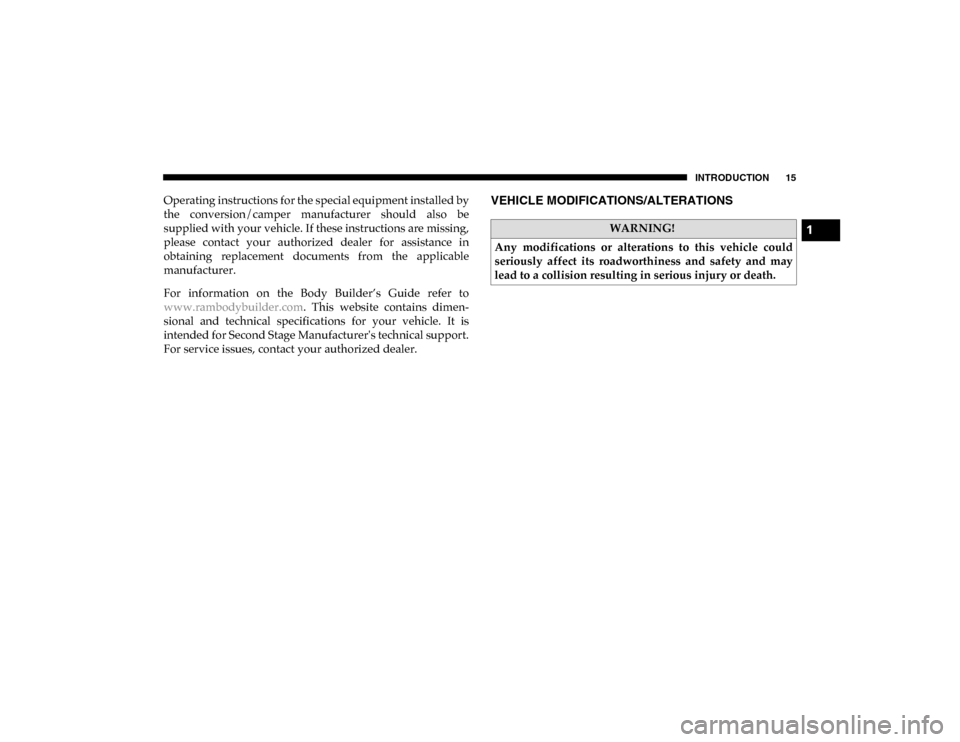
INTRODUCTION 15
Operating instructions for the special equipment installed by
the conversion/camper manufacturer should also be
supplied with your vehicle. If these instructions are missing,
please contact your authorized dealer for assistance in
obtaining replacement documents from the applicable
manufacturer.
For information on the Body Builder’s Guide refer to
www.rambodybuilder.com. This website contains dimen -
sional and technical specifications for your vehicle. It is
intended for Second Stage Manufacturer's technical support.
For service issues, contact your authorized dealer.VEHICLE MODIFICATIONS/ALTERATIONS
WARNING!
Any modifications or alterations to this vehicle could
seriously affect its roadworthiness and safety and may
lead to a collision resulting in serious injury or death.1
2020_DT_1500_OM_US.book Page 15
Page 299 of 674
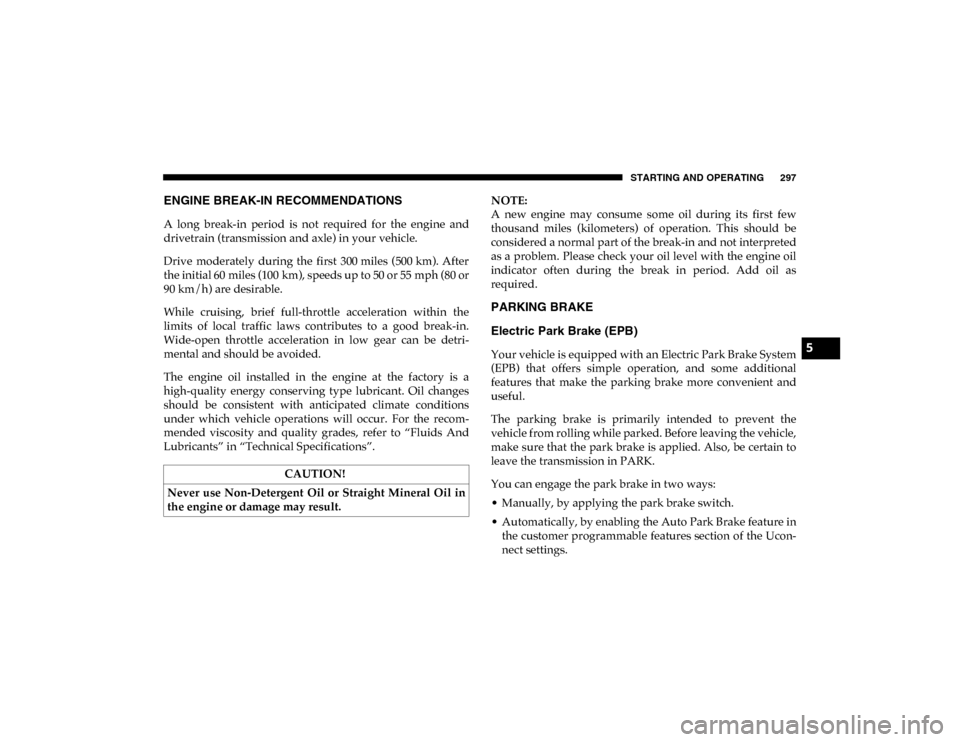
STARTING AND OPERATING 297
ENGINE BREAK-IN RECOMMENDATIONS
A long break-in period is not required for the engine and
drivetrain (transmission and axle) in your vehicle.
Drive moderately during the first 300 miles (500 km). After
the initial 60 miles (100 km), speeds up to 50 or 55 mph (80 or
90 km/h) are desirable.
While cruising, brief full-throttle acceleration within the
limits of local traffic laws contributes to a good break-in.
Wide-open throttle acceleration in low gear can be detri-
mental and should be avoided.
The engine oil installed in the engine at the factory is a
high-quality energy conserving type lubricant. Oil changes
should be consistent with anticipated climate conditions
under which vehicle operations will occur. For the recom -
mended viscosity and quality grades, refer to “Fluids And
Lubricants” in “Technical Specifications”. NOTE:
A new engine may consume some oil during its first few
thousand miles (kilometers) of operation. This should be
considered a normal part of the break-in and not interpreted
as a problem. Please check your oil level with the engine oil
indicator often during the break in period. Add oil as
required.
PARKING BRAKE
Electric Park Brake (EPB)
Your vehicle is equipped with an Electric Park Brake System
(EPB) that offers simple operation, and some additional
features that make the parking brake more convenient and
useful.
The parking brake is primarily intended to prevent the
vehicle from rolling while parked. Before leaving the vehicle,
make sure that the park brake is applied. Also, be certain to
leave the transmission in PARK.
You can engage the park brake in two ways:
• Manually, by applying the park brake switch.
• Automatically, by enabling the Auto Park Brake feature in
the customer programmable features section of the Ucon -
nect settings.
CAUTION!
Never use Non-Detergent Oil or Straight Mineral Oil in
the engine or damage may result.5
2020_DT_1500_OM_US.book Page 297
Page 469 of 674
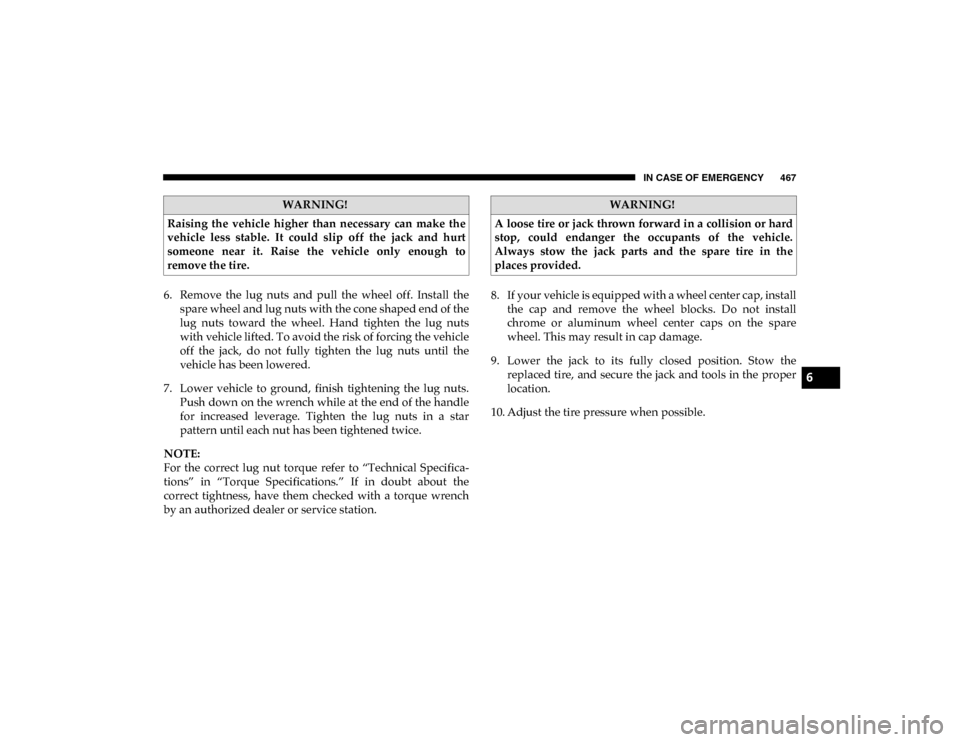
IN CASE OF EMERGENCY 467
6. Remove the lug nuts and pull the wheel off. Install thespare wheel and lug nuts with the cone shaped end of the
lug nuts toward the wheel. Hand tighten the lug nuts
with vehicle lifted. To avoid the risk of forcing the vehicle
off the jack, do not fully tighten the lug nuts until the
vehicle has been lowered.
7. Lower vehicle to ground, finish tightening the lug nuts. Push down on the wrench while at the end of the handle
for increased leverage. Tighten the lug nuts in a star
pattern until each nut has been tightened twice.
NOTE:
For the correct lug nut torque refer to “Technical Specifica -
tions” in “Torque Specifications.” If in doubt about the
correct tightness, have them checked with a torque wrench
by an authorized dealer or service station. 8. If your vehicle is equipped with a wheel center cap, install
the cap and remove the wheel blocks. Do not install
chrome or aluminum wheel center caps on the spare
wheel. This may result in cap damage.
9. Lower the jack to its fully closed position. Stow the replaced tire, and secure the jack and tools in the proper
location.
10. Adjust the tire pressure when possible.
WARNING!
Raising the vehicle higher than necessary can make the
vehicle less stable. It could slip off the jack and hurt
someone near it. Raise the vehicle only enough to
remove the tire.WARNING!
A loose tire or jack thrown forward in a collision or hard
stop, could endanger the occupants of the vehicle.
Always stow the jack parts and the spare tire in the
places provided.
6
2020_DT_1500_OM_US.book Page 467
Page 515 of 674
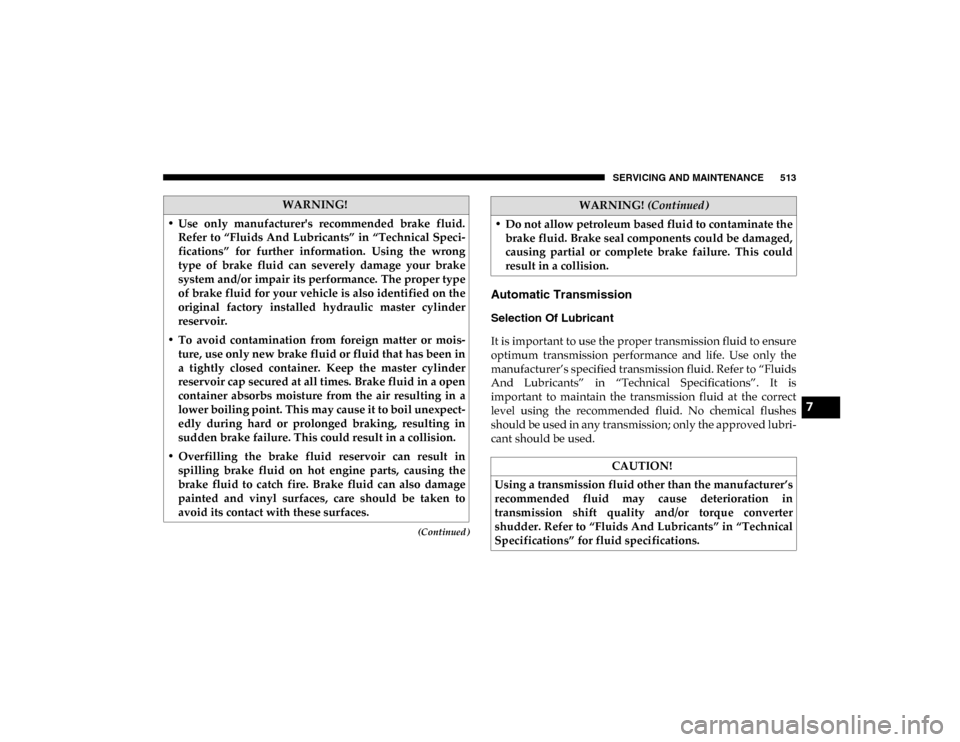
SERVICING AND MAINTENANCE 513
(Continued)
Automatic Transmission
Selection Of Lubricant
It is important to use the proper transmission fluid to ensure
optimum transmission performance and life. Use only the
manufacturer’s specified transmission fluid. Refer to “Fluids
And Lubricants” in “Technical Specifications”. It is
important to maintain the transmission fluid at the correct
level using the recommended fluid. No chemical flushes
should be used in any transmission; only the approved lubri-
cant should be used.
WARNING!
• Use only manufacturer's recommended brake fluid. Refer to “Fluids And Lubricants” in “Technical Speci -
fications” for further information. Using the wrong
type of brake fluid can severely damage your brake
system and/or impair its performance. The proper type
of brake fluid for your vehicle is also identified on the
original factory installed hydraulic master cylinder
reservoir.
• To avoid contamination from foreign matter or mois -
ture, use only new brake fluid or fluid that has been in
a tightly closed container. Keep the master cylinder
reservoir cap secured at all times. Brake fluid in a open
container absorbs moisture from the air resulting in a
lower boiling point. This may cause it to boil unexpect -
edly during hard or prolonged braking, resulting in
sudden brake failure. This could result in a collision.
• Overfilling the brake fluid reservoir can result in spilling brake fluid on hot engine parts, causing the
brake fluid to catch fire. Brake fluid can also damage
painted and vinyl surfaces, care should be taken to
avoid its contact with these surfaces.
• Do not allow petroleum based fluid to contaminate thebrake fluid. Brake seal components could be damaged,
causing partial or complete brake failure. This could
result in a collision.
CAUTION!
Using a transmission fluid other than the manufacturer’s
recommended fluid may cause deterioration in
transmission shift quality and/or torque converter
shudder. Refer to “Fluids And Lubricants” in “Technical
Specifications” for fluid specifications.
WARNING! (Continued)
7
2020_DT_1500_OM_US.book Page 513
Page 517 of 674
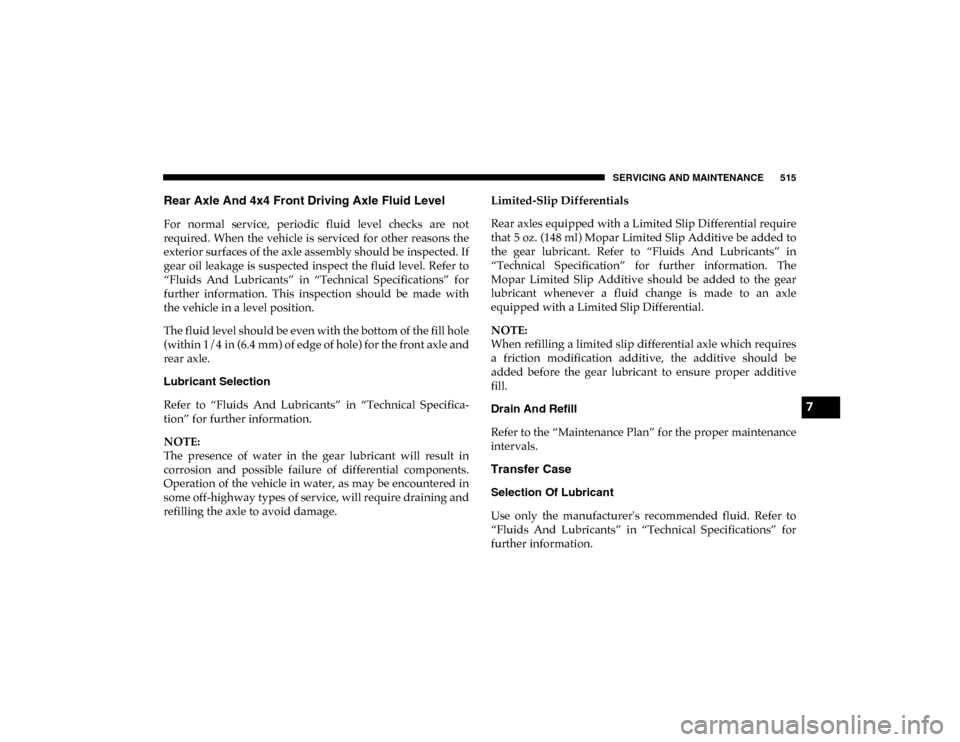
SERVICING AND MAINTENANCE 515
Rear Axle And 4x4 Front Driving Axle Fluid Level
For normal service, periodic fluid level checks are not
required. When the vehicle is serviced for other reasons the
exterior surfaces of the axle assembly should be inspected. If
gear oil leakage is suspected inspect the fluid level. Refer to
“Fluids And Lubricants” in “Technical Specifications” for
further information. This inspection should be made with
the vehicle in a level position.
The fluid level should be even with the bottom of the fill hole
(within 1/4 in (6.4 mm) of edge of hole) for the front axle and
rear axle.
Lubricant Selection
Refer to “Fluids And Lubricants” in “Technical Specifica-
tion” for further information.
NOTE:
The presence of water in the gear lubricant will result in
corrosion and possible failure of differential components.
Operation of the vehicle in water, as may be encountered in
some off-highway types of service, will require draining and
refilling the axle to avoid damage. Limited-Slip Differentials
Rear axles equipped with a Limited Slip Differential require
that 5 oz. (148 ml) Mopar Limited Slip Additive be added to
the gear lubricant. Refer to “Fluids And Lubricants” in
“Technical Specification” for further information. The
Mopar Limited Slip Additive should be added to the gear
lubricant whenever a fluid change is made to an axle
equipped with a Limited Slip Differential.
NOTE:
When refilling a limited slip differential axle which requires
a friction modification additive, the additive should be
added before the gear lubricant to ensure proper additive
fill.
Drain And Refill
Refer to the “Maintenance Plan” for the proper maintenance
intervals.
Transfer Case
Selection Of Lubricant
Use only the manufacturer's recommended fluid. Refer to
“Fluids And Lubricants” in “Technical Specifications” for
further information.
7
2020_DT_1500_OM_US.book Page 515
Page 548 of 674
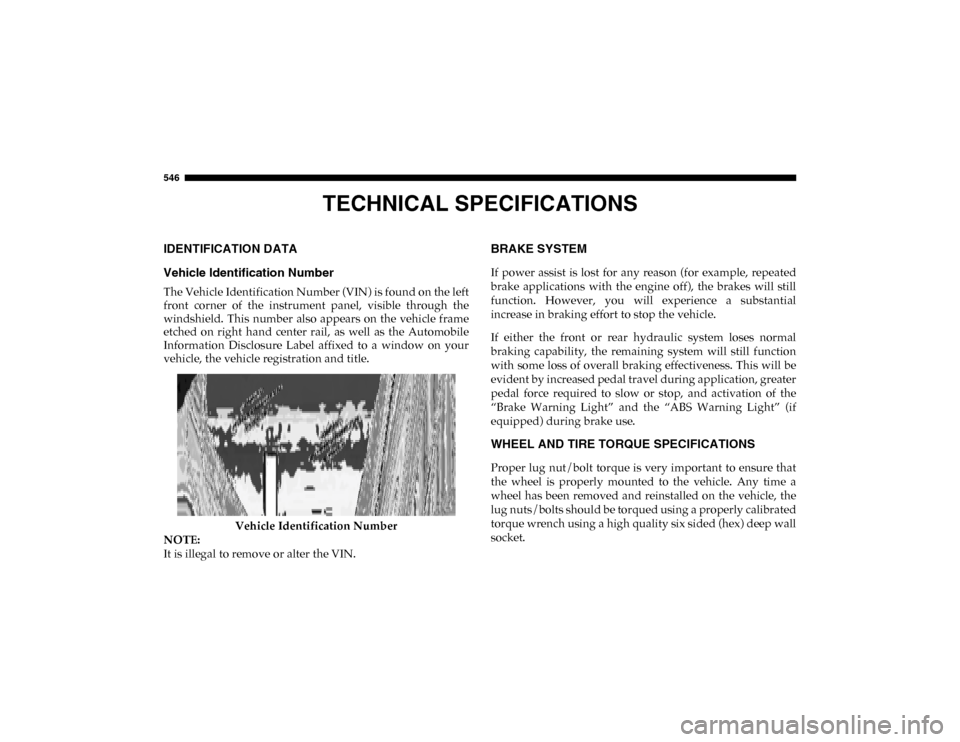
546
TECHNICAL SPECIFICATIONS
IDENTIFICATION DATA
Vehicle Identification Number
The Vehicle Identification Number (VIN) is found on the left
front corner of the instrument panel, visible through the
windshield. This number also appears on the vehicle frame
etched on right hand center rail, as well as the Automobile
Information Disclosure Label affixed to a window on your
vehicle, the vehicle registration and title.Vehicle Identification Number
NOTE:
It is illegal to remove or alter the VIN.
BRAKE SYSTEM
If power assist is lost for any reason (for example, repeated
brake applications with the engine off), the brakes will still
function. However, you will experience a substantial
increase in braking effort to stop the vehicle.
If either the front or rear hydraulic system loses normal
braking capability, the remaining system will still function
with some loss of overall braking effectiveness. This will be
evident by increased pedal travel during application, greater
pedal force required to slow or stop, and activation of the
“Brake Warning Light” and the “ABS Warning Light” (if
equipped) during brake use.
WHEEL AND TIRE TORQUE SPECIFICATIONS
Proper lug nut/bolt torque is very important to ensure that
the wheel is properly mounted to the vehicle. Any time a
wheel has been removed and reinstalled on the vehicle, the
lug nuts/bolts should be torqued using a properly calibrated
torque wrench using a high quality six sided (hex) deep wall
socket.
2020_DT_1500_OM_US.book Page 546
Page 549 of 674
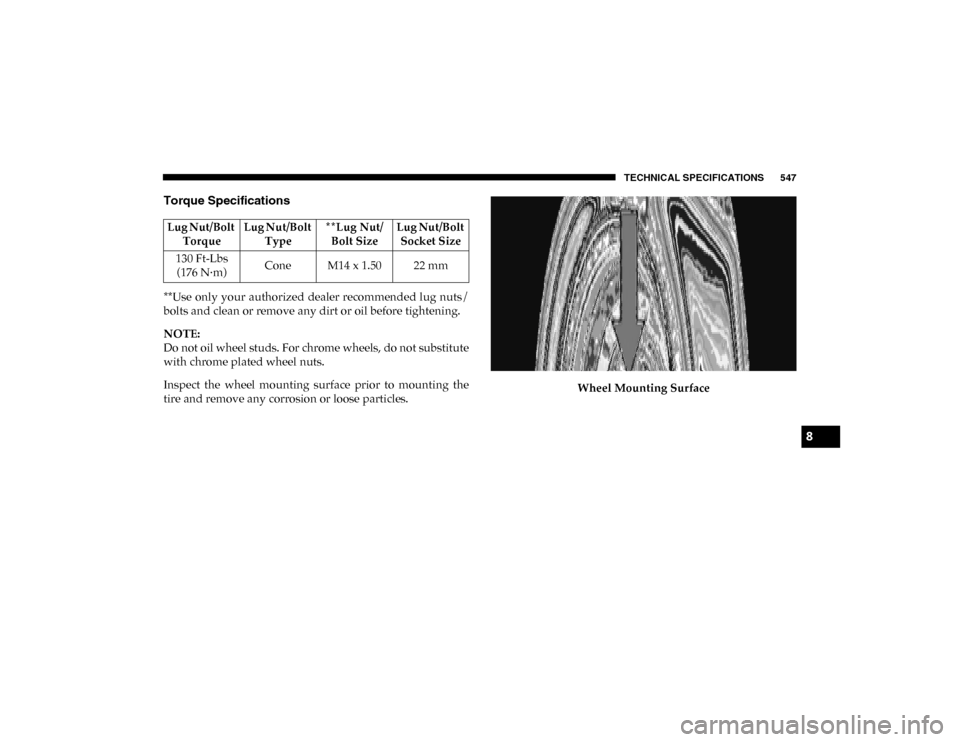
TECHNICAL SPECIFICATIONS 547
Torque Specifications
**Use only your authorized dealer recommended lug nuts/
bolts and clean or remove any dirt or oil before tightening.
NOTE:
Do not oil wheel studs. For chrome wheels, do not substitute
with chrome plated wheel nuts.
Inspect the wheel mounting surface prior to mounting the
tire and remove any corrosion or loose particles.Wheel Mounting Surface
Lug Nut/Bolt
Torque Lug Nut/Bolt
Type **Lug Nut/
Bolt Size Lug Nut/Bolt
Socket Size
130 Ft-Lbs (176 N·m) Cone M14 x 1.50 22 mm
8
2020_DT_1500_OM_US.book Page 547
Page 550 of 674
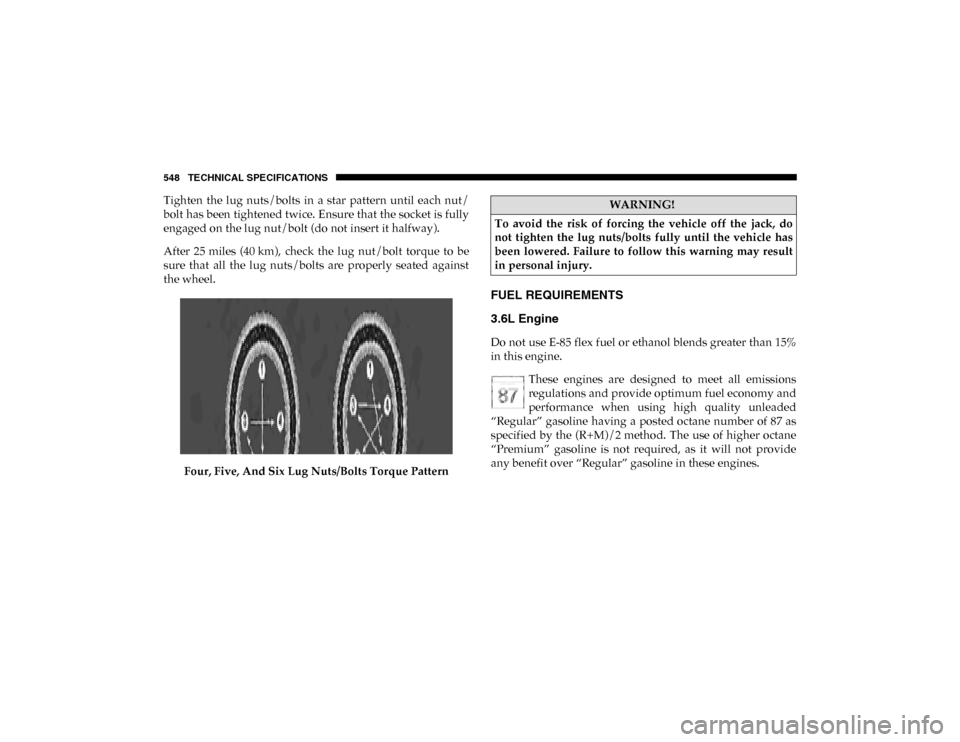
548 TECHNICAL SPECIFICATIONS
Tighten the lug nuts/bolts in a star pattern until each nut/
bolt has been tightened twice. Ensure that the socket is fully
engaged on the lug nut/bolt (do not insert it halfway).
After 25 miles (40 km), check the lug nut/bolt torque to be
sure that all the lug nuts/bolts are properly seated against
the wheel.Four, Five, And Six Lug Nuts/Bolts Torque Pattern
FUEL REQUIREMENTS
3.6L Engine
Do not use E-85 flex fuel or ethanol blends greater than 15%
in this engine. These engines are designed to meet all emissions
regulations and provide optimum fuel economy and
performance when using high quality unleaded
“Regular” gasoline having a posted octane number of 87 as
specified by the (R+M)/2 method. The use of higher octane
“Premium” gasoline is not required, as it will not provide
any benefit over “Regular” gasoline in these engines.
WARNING!
To avoid the risk of forcing the vehicle off the jack, do
not tighten the lug nuts/bolts fully until the vehicle has
been lowered. Failure to follow this warning may result
in personal injury.
2020_DT_1500_OM_US.book Page 548